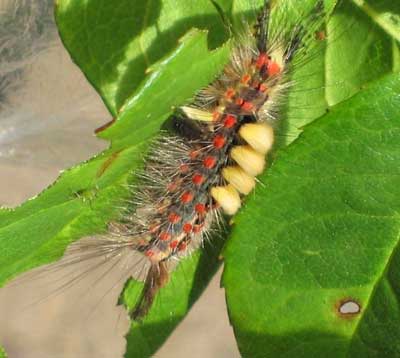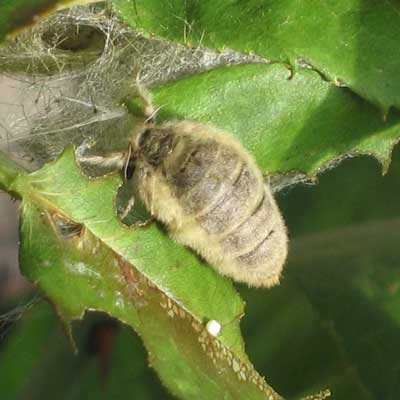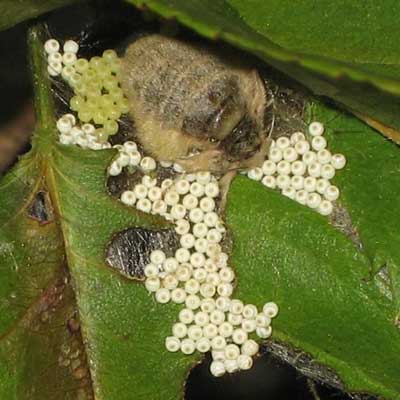A touch of the Vapourers
By Ruth D’Alessandro, The Wildlife Gardener The Wildlife Gardener agreed to water a friend’s roses while she went to Glastonbury. Little did I know that, a fortnight later, my neighbourliness would result in a covetable prize for nature anoraks like myself: a real-time peek into the life cycle of a moth: the Vapourer moth (Orgyia antiqua) to be more specific. I vaguely remembered my countryman Dad telling me that Vapourer moths were particularly interesting: they have feathery antennae and the females send out powerful sex pheromones that have males from miles around flocking to be her gentlemen callers. Caroline’s roses were covered in these groovy psychedelic Vapourer caterpillars that would not have looked out of place in the mosh pit at Glastonbury:

It has been years since I’ve kept caterpillars in a jar and hatched moths. I figured Caroline wouldn’t miss a few punk rose-destroyers, and it would be educational for the Junior Wildlife Gardeners to do some captive breeding. So, I put five itchy-looking caterpillars in a big glass vase with damp compost and rose branches from the Wildlife Garden, some perforated clingfilm on top and placed them on the kitchen windowsill where I could watch them as I washed up. The caterpillars munched away for a week or so, then activity quietened down. I kept an eye on the vase to see if any little chestnut-brown moths emerged. Nothing. So I took the vase out into the garden to have a closer look at its contents. Whoah! What’s this?:

This curious furry little bug is a female Vapourer moth. She is wingless, and the sole purpose of her short life is to mate and lay eggs. Because she can’t fly about, she emits strong pheromones to attract male Vapourers to come to her. I thought I’d test the pheromone thing, expecting nothing much to come of it. I took the clingfilm off the vase and put it on the garden table. If there were to be any moth-on-moth action, I expected it to take place at dusk or beyond: I hadn’t realised that Vapourer moths are day fliers. Within TEN MINUTES two virile male Vapourer moths had appeared, one luckier than the other:

This handsome chestnut male with his magnificent feathered antennae paid court to his furry partner for about half an hour, to the huge amusement of the JWGs who couldn’t believe they were watching moths’actually having a sex’. And then he flew off. Wasting no time, the female got on with her life’s work: laying eggs to make more Vapourer moths:

Aaah. I’ll leave the story at this point. There’s still one caterpillar munching away in the vase, a couple of cocoons that I can see, and very soon, there will be a dead female. And I’ll feel a little bit sad. But I’ll have some Vapourer moth eggs to overwinter and release into the Wildlife Garden next year. As my Dad said, Vapourer moths really are special.

- Spurn Spawn! - 26th February, 2014
- Bluebells on wheels: axles of evil? - 2nd February, 2011
- Raising the ba: Wildlife and the Ancient Egyptian Book of the Dead - 8th January, 2011

I have had the most interesting year with all of my vapourer moth babies. I had a female late last year who must have laid about one hundred eggs, I kept her in the top half of a propergator and waited until the babies hatched out. She herself died about six weeks after laying her eggs and since then I have had the delight to watch all caterpillars born and how very interesting they have been.i have had at least eighty percent born and have raised them in a small fish tank/aquarium and I’ve not been disappointed either. The caterpillars are very beautiful and fluffy, they have eaten all rose leaves which is where I found the first caterpillar. I have found them very successful to watch grow and when large enough I have put them out into the garden. I finally had the second male born tonight who is now out in the wild blue yonder to find his mate. Out of the eighty percent which I have reared I now have only five left. I have found this experience enthralling and exciting. I will definitely do it all again. I am now addicted to watching these little caterpillars which are so tiny to finally become quite large caterpillars and to have had two which turned into males is wonderful.
Hi!
I am researching on a new 3D David Attenborough series on the evolution of flight in animals. We are interested in the vapourer moth and the flightless females. they look incredible! Not like moths at all.
When do they emerge?I hear it is in late summer. Is it possible to force emergence early (spring? early summer?) or are there similar species that emerge earlier?
We would like to film eggs hatching, caterpillars, munching and adults mating if possible. how easy do you think this might be?
I would be really grateful if you could send me an email to jamesmanisty@atlanticproductions.co.uk if you think you could help me?
thanks very much!
James Manisty
Hello there. At this moment in time I have a female caper our moth which has laid eggs. I first found this really little furry caterpillar about middle of September. I kept it in a plant propergator so I could watch it indoors. Over approx 3weeks it body changed as it grew and sprouted more hairs. Little did I know the hairs would be for weaving its own cocoon. The one day a week later low and behold it was a little femalle on 3oct so I put her in greenhouse where no predators would get her and that lunchtime I found a gorgeous bright orange moth fluttering insid the propergator so I released it and now my female has laid approx 200 eggs. I’m thrilled. I believe it’s right to say that these eggs will overwinter so I will keep them safe until spring when caterpillars emerge. So excited now to be a part of nature. Good luck with your little ones. J Woodham wiltshire
Or, Beardie, the previous generations of females have found such perfect environments for eggs that they simply stay there and get the males to come to them.The females are absolutely loaded with eggs! It would be risky business mating and flying off and then finding a perfect environment. As you say, it must work somehow.
It’s just occurred to me that the vapourer moth has a fundamentally flawed dispersal strategy. Since the female is wingless, the eggs cannot be laid more than crawling distance from where she herself hatched. It would make more sense to have wingless males attracting winged females, which could then fly off to new territory after mating.
One could say that fig wasps have the better idea, but then the vapourer moths haven’t gone extinct, so it must work after a fashion.
The Vapourer dispersive stage is the first-instar caterpillar – they spin a long strand of silk and ride the air currents (‘ballooning’). This allows the females to spend all their energy on egg production, rather than development of wings and powerful flight muscles, and using energy carrying eggs through the sky.
Males carry lightweight reproductive equipment compared to females, which is why winglessness generally develops in females, rather than males
And I can’t believe the process went full circle when the eggs hatched out (Weren’t they suppose to overwinter?) into tiny black caterpillars! I let those go in the garden.
I thought it was a tick that sucked my catipillar dry :0 ;)!!!-Will,9 (P.S.I found it not my mum)
I was about to squish it with my foot when my bro pointed it out (as a caterpillar)while trying to climb a tree. I thought the process was unbelievabely quick. -Nannon,12
Lovely story. We too, have just witnessed the life-cycle from a stunning caterpillar to cocoon – to the,at first, rather alarming hatching of a female Vapourer Moth. On placing the jam-jar outside within 5 minutes she had 2 suitors, and now just 3 hours later she has laid many eggs. Totally fascinating and all rather poignant.
Sophie – apparently they eat most deciduous trees and shrubs, so very unfussy.
We’ve got these amazing creatures on our cherry tree and currant bush. Do you know if they like to eat anthing else? They seem quite eclectic in their eating habits for a caterpillar.
These are sensible dung beetles – after all, rabbit droppings are already round, makes rolling them much easier…
See – you don’t have to go to Egypt to see a dung beetle…
Cheers! Yes, it’s a native dung beetle, which feeds mainly on rabbit droppings – that one came to light when I was moth trapping at Harcourt Arboretum in Oxfordshire
The Brown Hairstreak photo shows it really well. LOVE your Flickr stream, especially the minotaur beetle. Is that a UK native? Never seen one before.
Yep, all lep eggs have a central hole for fertilisation, called the micropyle – it can be seen quite clearly on this Brown Hairstreak egg: http://www.flickr.com/photos/rcomont/4688096727/in/set-72157623927583165/ – the eggs are stored unfertilised inside the female, who stores the sperm package from the male seperately – as she lays each egg, the two are united, which is why eggs from roadkill leps, etc, are always infertile. Yours should be fine – they’ve not had to contend with the great outdoors!
ghostmoth – the most we can say is she gets the chance to be a saucy little minx with her ‘come hither’ pheromones, and she doesn’t die wondering! But apart from that, being a female Vapourer sucks.
That is sad. The female Vapourer is just a drab egg laying machine – she doesn’t even get to fly or sip nectar! Thanks for the opportunity to see their life cycle in action.
Hi Richard – how interesting! I’m hoping my little captive bred Vapourers will have avoided the parasitic wasps and will overwinter, but who knows? You’ve also answered a query I had – I wondered how the eggs were fertilised so rapidly – through a micropyle. I hoped to give my little female some sugary water as a reward for her efforts, but she doesn’t have mouthparts! She’s sitting quietly by her eggs waiting for the end of her life just now. How sad is that? Very ‘Charlotte’s Web’.
I found a batch of Vapourer eggs a few weeks ago – this week they hatched, but not into larvae – each and every eggs had been parasitised by a tiny wasp, which is so small that it actually lays its egg through the micropyle, the hole in the eggshell used for fertilisation – fantastic little things!